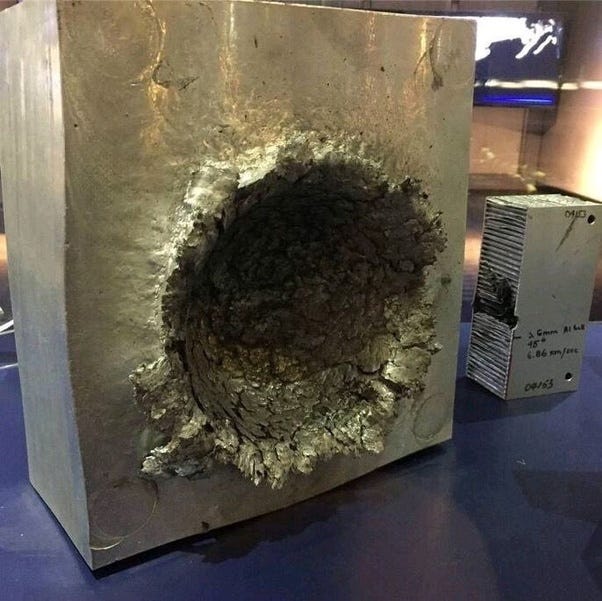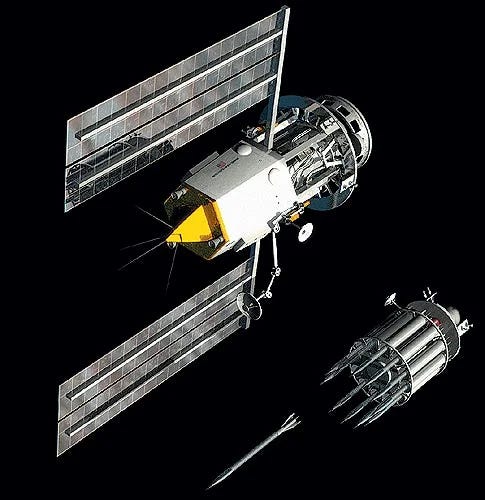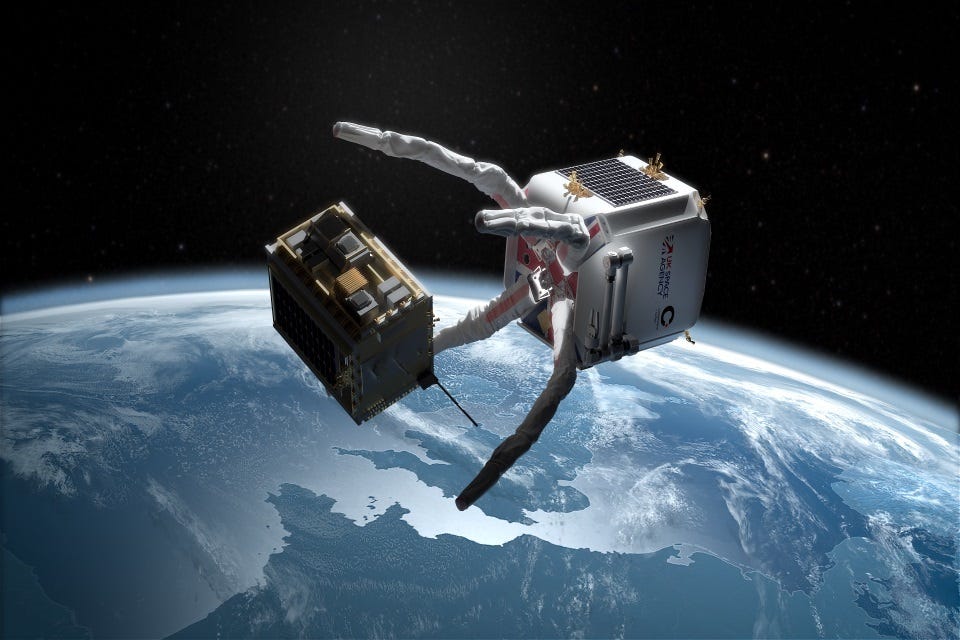“You are my war club, my weapon for battle — with you, I shatter nations; with you, I destroy kingdoms.”
– Jeremiah 51:20
There are international space treaties that prohibit nuclear, biological, or chemical weapons from being placed or used from Earth’s orbit - bummer. Nevertheless, we could still use something nicknamed “Rods from God,” a bundle of telephone-pole-sized (20 feet long, one foot in diameter. 6 meters long and 0.3 meters in diameter) tungsten rods that can be dropped from orbit, reaching a speed of up to 30 times the speed of sound (24,545 miles per hour. 39,501 km per hour ) and with the power of intercontinental ballistic missiles, delivered anywhere around the world under 15 min, it can destroy target 30 meters underground (98 feet), - with no nuclear fallout.
For comparison, MOAB (Massive Ordnance Air Blast) also known as Mother Of All Bombs - is one of the most powerful non-nuclear explosives on Earth. When it detonated, it released about 11 tons of TNT. A “Rod from God” would have the same energy.
The Kinetic energy of an object is directly proportional to its mass, and its velocity squared.
KE = (1/2)mv^2Increasing the mass 10 times, increases the kinetic energy 10 times.
If you increase the velocity by a factor of 10, you increase KE by 100. This is why small light objects can carry lots of kinetic energy.
This is a block of aluminum after it was hit by a 14-gram piece of plastic that was traveling 24,000 feet per second (26,000 kmph/16,000 mph) in space.
This is a serious problem for space stations and satellites. This makes even a spec of paint a dangerous weapon.
This is a picture of the window in the ISS, that was cracked by a flake of paint floating in orbit.
This is a picture of how a tiny object punctured a hole in the robotic arm of the ISS.
Now imagine an object that weighs 10 tons, traveling at that speed. Imagine the damage it could cause. Here is a rendering of what the machine could look like.
This puppy is still theoretical, since the main drawback is the cost of getting the rods to Near-Earth orbit. It would cost around $60 million per rod, $2,500 per pound to put anything in space, with 20 cubic feet of dense tungsten weighing in at just over 24,000 pounds.
But I’ll show you how to get this baby running for cheap cheap. I’m not saying I’ll tell you how to dramatically reduce the cost of getting payloads into space. I’m saying the material is already in Near-Earth orbit… Space debris.
You see, dear reader, I’m a strong ESG advocate. We should invest heavily in recycling technology, you know… for the environment! The amount of space debris is increasing, flying around our planet at 17,500 miles per hour (28,000 kilometers per hour). This will become a huge problem for humanity, like a growing cancer, or rather a syndrome - the Kessler syndrome.
Kessler Syndrome
First proposed by NASA scientist Donald J. Kessler in 1978, it describes a scenario where the density of objects in low Earth orbit is high enough that collisions between objects could cause a cascade effect, leading to an exponential increase in space debris. This space debris poses a significant risk to satellites, space stations, and any future space missions, potentially isolating Earth by creating an impenetrable barrier of fast-moving debris.
The implications of Kessler Syndrome are dire. The most immediate impact would be on global communications. Everything from GPS navigation to international phone calls. And then you have the second-order effects of those things going down. It would make both life on Earth and space travel extremely difficult.
So, in order to avoid the disruption of all our logistics on Earth that use GPS, communications shutdowns, and being trapped in a cage of space trash, one of the solutions is to collect that trash. You save the world while building the most powerful weapon - two birds, one stone.
But can a garbage man do all these things?
As of June 2023, there are over 37,000 known objects larger than 10 cm in low-earth orbit. This should be enough for around two rods. In 2019 there were 34,000; in four years, we got 3,000 more pieces of trash. It’s a growth opportunity!
“But the rods have to be made of tungsten!” Yeah, maybe. Think of it this way. The temperature of re-entry through the atmosphere is as high as 3000 degrees Fahrenheit. We’re a garbage collection company, right? maybe we only need the trash can to be resistant to the heat.
The Trash Can
We have different solutions for the outer layer of the trash can that we could look at.
Refractory Metals: Tungsten and molybdenum, for instance, have very high melting points (3422°C and 2623°C respectively) making them suitable for high-temperature applications.
Ceramics: Materials like zirconium carbide and silicon carbide are used in high-temperature applications due to their high melting points and ability to withstand thermal shock.
Carbon-based Materials: Graphite and carbon composites are used for their excellent thermal stability and strength at high temperatures. For instance, reinforced carbon-carbon (RCC) was used in the Space Shuttle's nose and wing leading edges.
Ablative Materials: These are designed to absorb heat while undergoing a controlled erosion. They are often used in heat shields for spacecraft. Phenolic-impregnated carbon ablator (PICA) is an example known for its lightweight and effective heat dissipation properties.
Heat-Resistant Alloys: Nickel-based superalloys, such as Inconel, can maintain strength at high temperatures, making them suitable for components like jet engines and re-entry vehicles.
Thermal Barrier Coatings: These coatings, such as yttria-stabilized zirconia, are applied over a substrate material to insulate it from extreme temperatures.
Once we have a trash can that can withstand re-entry, we work on garbage collection.
Garbage Collection
There are different approaches to removing debris, but the one that seems the most effective is from a program that uses a net, called RemoveDEBRIS.
After having the trash can, we need to ensure the trash we put inside won’t damage it. For that, we could use some sort of insulating spray foam, to consolidate all the pieces of trash together into one. Sprayed aerogel with some non-flammable binder or other resins should do the trick. The other option would be to use a compactor.
Once you have your ESG-leading environmentally-friendly company going, collecting trash around orbit to save the world, you put all the trash together in the big trash can, and one day… “Whoops, I dropped the trash can.”
Melting the trash
We don’t need the insulating foam to keep all the trash “cool” from the heat of re-entry. What we want is a controlled melt of the trash inside the can as it re-enters the atmosphere. Too much heat and the trash will evaporate before impact. If the trash doesn’t melt enough, the pieces will move around, and course correction of the projectile becomes impossible - and the whole point of this device should be its surgical precision. To fix that, you can use some metallic foam, such as silicon carbide.
Expansion
Space debris collection is a growing industry, as the amount of trash is increasing. But besides that, the next steps would be to redirect asteroids and to build the lunar mass driver, an electromagnetic catapult.
In the meantime, we can collect some broken pieces of pottery floating in space.
"To the one who is victorious and does my will to the end, I will give authority over the nations — And he shall rule them with a rod of iron, as the vessels of the potter are broken to pieces, as I also have received authority from My Father."
– Revelation 2:26-27













